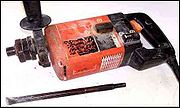
Hammer drill
Encyclopedia

Drill
A drill or drill motor is a tool fitted with a cutting tool attachment or driving tool attachment, usually a drill bit or driver bit, used for drilling holes in various materials or fastening various materials together with the use of fasteners. The attachment is gripped by a chuck at one end of...
with a hammering action. The hammering action provides a short, rapid hammer thrust to pulverize relatively brittle material and provide quicker drilling with less effort. Lower power units are usually titled as "hammer drills." Higher power units, usually labeled "rotary hammers," tend to be larger and provide bigger impact forces. Modern units allow the hammer and rotation functions to be used separately or in combination, i.e., hammer mode, drill mode, or both. When used in the hammer mode, the tool provides a drilling function similar to a jackhammer
Jackhammer
A jackhammer is a pneumatic tool that combines a hammer directly with a chisel that was invented by Charles Brady King. Hand-held jackhammers are typically powered by compressed air, but some use electric motors. Larger jackhammers, such as rig mounted hammers used on construction machinery, are...
. The definitive origin of the first hammer drill is a matter of discussion. Hilti had a rotary hammer on the market in 1967 http://www.hilti.com/holcom/page/module/home/browse_main.jsf?lang=en&nodeId=-8088 and the Milwaukee Electric Tool Corporation claims that in 1935, it was selling a lightweight 1/4-inch electric hammer drill http://www.milwaukeetool.com/About/MilwaukeeStory/HistoryOfMilwaukee.aspx.
Hammer drills are well suited for drilling holes in masonry
Masonry
Masonry is the building of structures from individual units laid in and bound together by mortar; the term masonry can also refer to the units themselves. The common materials of masonry construction are brick, stone, marble, granite, travertine, limestone; concrete block, glass block, stucco, and...
or stone. They are also used to drill holes in concrete footings to pin concrete wall forms and to drill holes in concrete floors to pin wall framing. The hammering action helps to break up the masonry so that it can be removed by the drill bit's flutes.
Types of hammer drills
There are two main types of hammer drill, percussion and rotary hammer. With percussion drills the chuck has a mechanism whereby the entire chuck and bit move forward and backwards on the axis of rotation, the motion is tied to the rotation of the chuck. Typically this type of drill can be used with and without the hammer action but it is not possible to use the hammer action alone as it is the rotation which causes the hammer motion. The second type uses a different type of chuck which allows the bit to move forwards and backwards independently and is usually powered pneumatically. As such this type of drill can be used in hammer-only mode which has certain advantages when dealing with very hard substances.Use
A hammer drill has a specially designed clutch that allows it to not only spin the drill bit, but also to punch it in and out (along the axis of the bit). The actual distance the bit travels in and out and the force of its blow are both very small, and the hammering action is very rapid—thousands of "BPM" (blows per minute) or "IPM" (impacts per minute). Although each blow is of relatively low force, these thousands of blows per minute are more than adequate to break up concrete or brick, using the masonry drill bit's carbide wedge to pulverize it for the spiral flutes to whisk away. For this reason, a hammer drill drills much faster than a regular drill through concrete or brick.Hammer drills almost always have a lever or switch that locks off the special "hammer clutch," turning the tool into a conventional drill for wood or metal work. Hammer drills are more expensive and more bulky than regular drills, but are preferable for applications where the material to be drilled—concrete block or wood studs—is unknown. For example, an electrician would use a hammer drill for attaching items (such as an electrical box) to either wood studs (if used as a conventional power drill) or masonry walls (if used as a hammer drill).
Rotary hammers

A number of "special shanks" have been developed by various manufacturers. Over the years a fair number of these proprietary systems evolved, but the remaining shanks in use today are: SDS, SDS-MAX, and SPLINE SHANK.
Rotary hammer drills have an oil filled gearbox, which allows them to operate durably despite the large forces and shocks they receive and the grit-filled environments where they are often used.
Apart from their main function of drilling concrete, the rotary action can be switched off and use is made of just the percussive force. Chisel and point accessories are used for small chipping jobs.
The type of work they do means that they need to have a clutch which cuts in when the drill bit jams. This stops the violent wrenching motion that a drill without a clutch would cause when stopped suddenly from full speed, saving both drill and operator from damage.
Jams are most often caused by hitting reinforcing steel or by a worn bit. In both cases the drill must be disengaged from the bit and the jammed bit backed out of the hole with vise grips or monkey wrench.

External links
- Rotary Hammer Drill A non commercial help site.
- NIOSH Sound Power and Vibrations Database
- New York City Quiet Vendor Guidelines
- Impact Driver VS Drill

